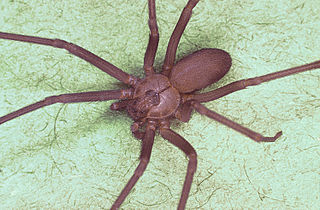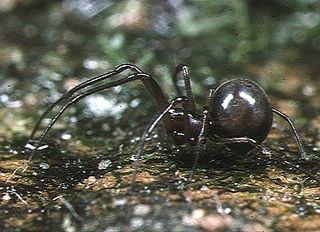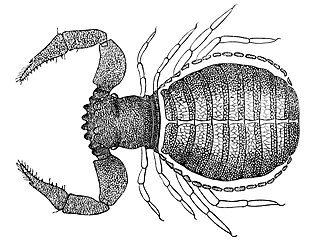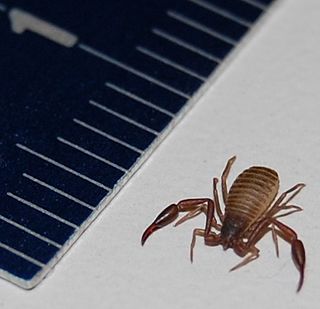
Pseudoscorpions, also known as false scorpions or book scorpions, are small, scorpion-like arachnids belonging to the order Pseudoscorpiones, also known as Pseudoscorpionida or Chelonethida.

Sicariidae is a family of six-eyed venomous spiders known for their potentially necrotic bites. The family consists of three genera and about 160 species. Well known spiders in this family include the brown recluse spider and the six-eyed sand spider.

The family Cyrtaucheniidae, known as wafer-lid trapdoor spiders, are a widespread family of Mygalomorphae spiders.

Scaffold web spiders or cave cobweb spiders (Nesticidae) are a family of araneomorph spiders closely allied with tangle-web spiders (Theridiidae). Like the Theridiidae, these spiders have a comb of serrated bristles on the hind tarsi that are used to pull silk bands from the spinnerets. Nesticidae contains 16 genera and about 300 species, many of which are associated with caves or overhangs. The genus Nesticus is the type for the family and is found throughout the world. The related Eidmannella has speciated considerably in Texas caves and includes some extremely localized species that are considered threatened. One species, Eidmannella pallida, is found in caves and under overhangs, but also in agricultural fields and other habitats away from such restricted areas. The genus Carpathonesticus is found in central Eurasia.

Anapidae is a family of rather small spiders with 232 described species in 58 genera. It includes the former family Micropholcommatidae as the subfamily Micropholcommatinae, and the former family Holarchaeidae. Most species are less than 2 millimetres (0.079 in) long.

The Chthonioidea are a superfamily of pseudoscorpions, representing the earliest diverging and most primitive living pseudoscorpions. The superfamily contains two families.

The Feaellidae are a family of pseudoscorpions with the single genus Feaella.
Fissilicreagris is a genus of pseudoscorpions in family Neobisiidae, first described by Božidar Ćurčić in 1984.

Chthoniidae is a family of pseudoscorpions within the superfamily Chthonioidea. The family contains more than 600 species in about 30 genera. Fossil species are known from Baltic, Dominican, and Burmese amber. Chthoniidae now includes the former families Tridenchthoniidae, and Lechytiidae which has been demoted to subfamilies.

Chelifer cancroides, the house pseudoscorpion, is a species of pseudoscorpion. It is the most widely distributed species of pseudoscorpion in the world, it occurs in a range of habitats, but it is mostly synanthropic and harmless to humans.

Chernetidae is a family of pseudoscorpions, first described by Anton Menge in 1855.
Geogarypidae is a family of pseudoscorpions, which was described in 1930 by American arachnologist Joseph Conrad Chamberlin.
Atemnidae is a family of pseudoscorpions, first described by Kyukichi Kishida in 1929.
Catalog of Fishes is a comprehensive on-line database and reference work on the scientific names of fish species and genera. It is global in its scope and is hosted by the California Academy of Sciences. It has been compiled and is continuously updated by the curator emeritus of the CAS fish collection, William N. Eschmeyer.

Cheliferidae is a family of pseudoscorpions in the order Pseudoscorpiones, first described by Antoine Risso in 1827.
Mesochelifer is a genus of pseudoscorpions in the family Cheliferidae, first described by Max Vachon in 1940.

Withiidae is a family of pseudoscorpions, first described by Joseph Conrad Chamberlin in 1931.
Hyidae is a family of pseudoscorpions. It was described in 1930 by American arachnologist Joseph Conrad Chamberlin.
Anysrius is a genus of pseudoscorpions in the Syarinidae family. It is endemic to the Australian state of Tasmania. It was described in 1998 by Australian arachnologist Mark Harvey. The genus name Anysrius is an anagram of its sister genus Syarinus.










